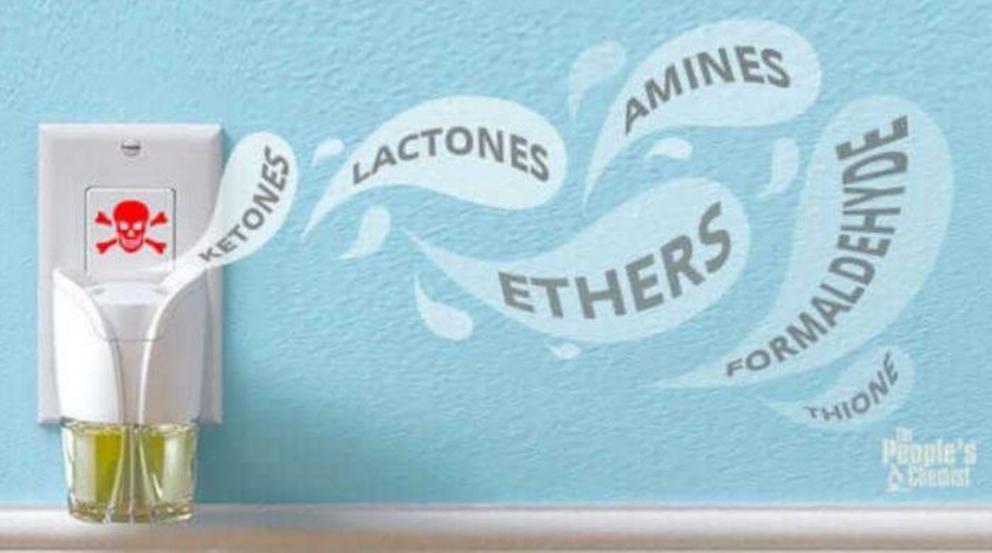The charms and harms of air fresheners
Are you aware that “secondhand scents” or indirect exposure to room air fresheners raise parallel concerns to “secondhand tobacco smoke”? Professor Anne Steinemann of the University of Melbourne in Australia [1] submits that connection.
Professor Steinemann, whose work I have followed for a few years, recently emailed me a list of some of her recent papers published regarding research on chemical exposures, fragranced consumer products, and health effects, which I’d like to introduce my readers to because your lungs and immune systems are under constant chemical vapor attack from scents you can control and those you cannot, e.g., a coworker’s obnoxious perfume or aftershave cologne, aerial sprays, manufacturing emissions, exhaust fumes, etc.
Scented dryer sheets, which impregnate bedding and clothing, are serious, heavy duty scents that can precipitate asthma attacks, bronchitis, allergic reactions, and/or exacerbate COPD problems. Many scents and scented products contain formaldehyde, a probable human carcinogen [2].
Why do I want to introduce the matter of scents and scented products? The prime reason is because we are being assaulted from on high with chemtrails spraying, which contain any number of chemical products and other ‘things’ that fall to earth and float in the air we are forced to breathe. Lung cancer is on the rise in non-smokers! According to MedPageToday,
Never-smokers accounted for 13% of non-small cell lung cancer (NSCLC) cases at the beginning of the study period and rose steadily to 28% by November 2014. … The reasons for the increase in nonsmokers among patients with NSCLC remain unclear.
Rates in U.S. and U.K. doubled since 2008 without obvious clues.
There are clues, in my opinion, which are in plain sight, i.e., all those scented products available, plus our noses, bronchi and lungs also ‘tell’ us something smells chemically! Some chronic respiratory diseases which are on the rise include:
- Asthma
- Bronchiectasis
- Chronic obstructive lung disease, including chronic obstructive pulmonary disease, bronchitis and emphysema
- Chronic rhinosinusitis
- Hypersensitivity pneumonitis
- Lung cancers and neoplasms of respiratory and intrathoracic organs
- Lung fibrosis
Dr. Steinemann states as a conclusion in her open access article “Ten questions concerning air fresheners and indoor built environments,” published at Elsevier Building and Environment, Vol. 111, January 2017, Pages 279-284,
[A]ir fresheners are used throughout society, often with the intent to create a favorable indoor environment. However, air fresheners may come with unintended and perhaps invisible risks. This article looked at the science, health and policy dimensions of air fresheners, and offered research findings and directions on ways to improve the air quality indoors and reduce potential exposures to pollutants.
Some of Dr. Steinemann’s open source articles, which may help readers to understand the problems associated with scented product use include:
Effects of fragranced products on asthmatics in the USA: 64.3% of asthmatics report adverse health effects from exposure to fragranced products such as air fresheners and cleaning supplies https://link.springer.com/article/10.1007/s11869-017-0536-2
Prevalence of multiple chemical sensitivities United States: 25.9% of the general population report chemical sensitivity, and 6.5% report medically diagnosed MCS, representing an increase of more than 200% and 300%, respectively, in the past decade
https://journals.lww.com/joem/Fulltext/2018/03000/National_Prevalence_and_Effects_of_Multiple.17.aspx
Fragranced consumer products and health effects in America: 34.7% report adverse health effects https://link.springer.com/article/10.1007/s11869-016-0442-z
Air fresheners and indoor air quality: why air fresheners impair rather than improve air quality
https://www.sciencedirect.com/science/article/pii/S0360132316304334
Regarding the above mix, consumers need to study, and factor in, an unseen quantifier that adversely impacts all bodily systems—but especially the skin and sweat glands. It’s electromagnetic frequencies from Wi-Fi, cell phones and towers, and more specifically 5G, the next upgrade in faster speeds for computers, iPhones, computer games, etc. The video below explains some of the skin problems attributed to 5G.
Since the human body is about 60% water [3], we need to look more closely at how all that’s going on in the world of chemicals, pharmaceuticals, agriculture and technology advances will impact—and are impacting—humans’ ability to maintain optimal health.
Become conscious of the chemicals in the products you buy for your home, especially scented products, bug sprays and lawn chemicals. You can check for harmful ingredients at http://householdproducts.nlm.nih.gov/
References:
[1] https://www.sciencedirect.com/topics/earth-and-planetary-sciences/tobacco-smoke
[2] https://www.cancer.gov/about-cancer/causes-prevention/risk/substances/formaldehyde/formaldehyde-fact-sheet
[3] https://water.usgs.gov/edu/propertyyou.html

